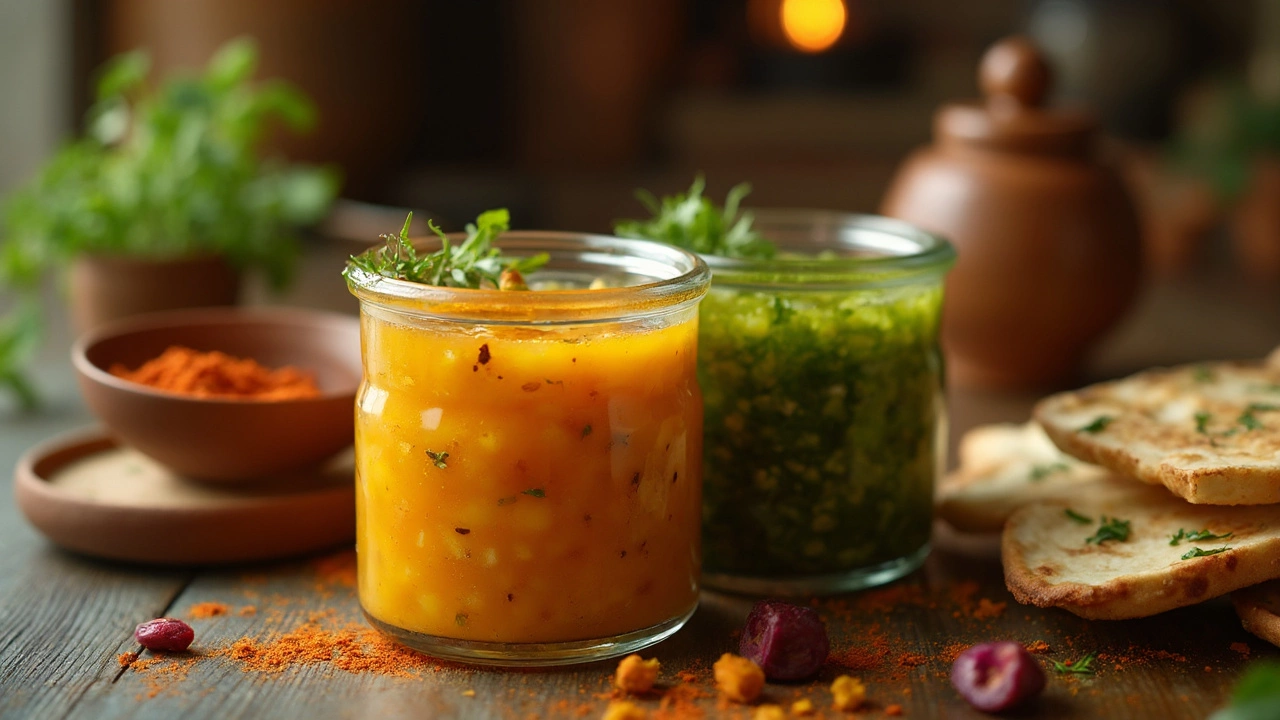Ever stared at two jars—one labeled chutney, one labeled relish—and wondered what's the big deal? These two favorites look similar on the shelf, but trust me, their stories and flavors are a world apart. Knowing when to grab chutney vs. relish can totally change your meal, from simple sandwiches to fancy cheese boards.
If you’ve ever gotten confused at a picnic or during a recipe swap, you’re not alone. The differences can be sneaky, but they matter. Each one brings its own punch—be it spicy, sweet, tangy, or crunchy. Plus, how you use them can upgrade your food from just okay to unforgettable.
- What Defines Chutney and Relish?
- Ingredients: What's in the Jar?
- How They’re Made: Methods and Traditions
- How to Use: Perfect Pairings and Surprises
- Fun Facts, Storage, and Kitchen Tips
What Defines Chutney and Relish?
The mix-up between chutney and relish isn’t just about the names—they’ve actually got different roots, flavors, and kitchen personalities. Chutney is a classic from Indian cuisine, showing up on tables for centuries. These blends started as a way to preserve fruits, veggies, and spices through long, slow cooking with vinegar or lemon juice. English cooks brought chutney home during colonial times, adding more sugar and vinegar, and that’s how it spread worldwide.
Relish is a product of good old-fashioned pickling, common in American and European kitchens. Unlike chutney, relish usually means chopped or grated veggies, soaked in vinegar, and cooked (or not cooked much at all). Think of relish as the crunchier, sharper cousin—perfect for zapping up hotdogs or burgers, while chutney leans sweet and thick, perfect alongside curries or cheese.
- Chutney: Slow-cooked, soft, sweet-and-sour, often contains fruit, and gets its main kick from spices.
- Relish: Crunchy or chunky, more sour, usually made with vegetables, and pickles are a big deal here.
Check out this quick fact table:
| Type | Main Base | Texture | Typical Use |
|---|---|---|---|
| Chutney | Fruit/Vegetable + Spice | Soft, Jammy | Curry, Cheese, Roasts |
| Relish | Vegetable (like cucumber) | Crunchy, Chunky | Burgers, Sandwiches, BBQ |
So, when you’re sorting your fridge or grocery list, just remember—chutney is for deep flavors and softness, while relish is all about fresh crunch and tang, ready to perk up everyday eats.
Ingredients: What's in the Jar?
If you peek inside a jar of chutney, you’re usually staring at a thick, chunky sauce packed with fruits or sometimes veggies, plus an armful of spices. Common picks are mango, apple, tomato, or even coconut. It’s all about slow cooking—the longer, the better. That’s how the fruits get ultra-soft and loaded with flavor. Almost every solid Indian-style chutney has vinegar and sugar to balance the spicy kick. Think cinnamon, ginger, or mustard seeds mixed in too.
On the other hand, relish is more about crunch. Diced veggies like cucumber, onion, peppers, or even corn get chopped up small and pickled lightly. The star flavor? Vinegar. Relish recipes dial down the sweetness and turn up the tang—sometimes with mustard, sometimes with nothing more than salt and a little sugar. You’re not going to find bold, complex spices here; it’s meant to be sharp and refreshing.
- Chutney: Fruit-heavy, more sugar, mix of sweet and savory spices.
- Relish: Veggie-based, more vinegar, usually less sweet, goes big on tang.
Here’s a quick look at what might end up in your jars:
| Chutney Staples | Relish Staples |
|---|---|
| Mango | Cucumber |
| Tomato | Onion |
| Apple | Bell Pepper |
| Spices (mustard, ginger, cinnamon) | Vinegar, little sugar |
So if you’re whipping something up or picking a jar off the shelf, remember—chutney is fruit-and-spice central, while relish is your crisp veggie sidekick.

How They’re Made: Methods and Traditions
Making chutney and relish is almost like following two different family recipes. Chutney, especially the classic Indian kind, starts with fruits or veggies simmered slowly with sugar, vinegar, and spices. The goal? Cook everything down until the whole thing is thick, a little sticky, and well-blended. Traditional mango chutney, for example, can cook for an hour or more to get that bold, rich taste. The main spices usually include ginger, mustard seed, or sometimes even chilies for heat. Some British-style chutneys drop the heat and go heavier on the sweet and tangy.
Relish has a different vibe. Instead of a long simmer, you chop or grate veggies—think cucumbers, bell peppers, onions—and mix them with vinegar, sugar, and sometimes mustard seeds or celery seed. Most relish recipes want the stuff to stay chunky and have a crunch. Everything comes together a lot faster—some classic pickle relishes only need about 30 minutes on the stove or no cooking at all if you go the raw route.
- Chutney: Slow-cooked, ingredients meld together, flavors blend deeply.
- Relish: Quick-cooked or raw, ingredients keep their separate textures, flavors pop individually.
Look at it like this: a chutney is about blending everything into one jammy mix, while a relish celebrates each veggie or fruit for what it is. That’s why you see chutney spread on curries and roast meats, and relish tossed onto hot dogs or stirred into salads.
| Process Step | Chutney | Relish |
|---|---|---|
| Preparation | Chop, sometimes peel fruit/veg | Finely chop or grate veggies |
| Cooking Time | 45–120 min (slow simmer) | 5–30 min (or raw, no cook) |
| Texture | Thick, blended | Chunky, often crunchy |
| Spices | Wide range—ginger, mustard, cumin, chili | Mostly mustard, celery seed, dill |
Here’s a tip: for chutney, use a heavy-bottomed pan and don’t rush the simmer. With relish, taste as you go—you want it crisp, not mushy. These tweaks set the two apart every time.
How to Use: Perfect Pairings and Surprises
This is where chutney and relish start to show their true personalities. These condiments may look alike, but they're used in totally different ways depending on what you want from your food. Let’s break it down so you can make the most of every jar in your kitchen.
Chutney is usually thicker, chunkier, and packs a bold punch—sweet and spicy flavors, sometimes tangy too. Popular pairings? Indian curries, samosas, roast meats, or even something as simple as cheese on toast. A scoop of mango chutney lifts a basic chicken salad sandwich into something special, and tomato chutney can make burgers next-level. Don’t forget about pairing chutney with grilled veggies, or even topping off scrambled eggs. It’s way more versatile than people give it credit for.
Relish, on the other hand, is all about tang and crunch. Think of that classic pickle relish on hot dogs at baseball games, or spooned over bratwursts, burgers and sausages. Relish cuts through the richness, adds brightness, and gives food a texture boost. You’ll also see relish popping up in tuna or potato salad, as it mixes in super easily without overpowering other flavors.
- Chutney: Cheese platters, roasted or grilled meats, Indian dishes, sandwiches, eggs, even in marinades.
- Relish: Hot dogs, burgers, sausages, potato salads, deviled eggs, mixed into sauces and dips.
Here’s a quick comparison of where you might see each one shine:
| Dish | Chutney | Relish |
|---|---|---|
| Hot Dog | Nope (overpowers) | Classic choice! |
| Chicken Curry | Perfect match | Doesn’t fit flavor-wise |
| Cheese Board | Spot-on | Not usually served |
| Burger | Great for a twist | Standard topping |
Want to surprise your guests? Try using a tangy green tomato relish instead of mustard in deviled eggs or swap in spicy apple chutney on pork chops. As chef Meera Sodha puts it:
“Chutneys aren’t just for curries; use them to give sandwiches and cheese platters a much-needed kick.”
Don’t limit yourself—the best kitchen discoveries happen when you mix things up. Even a spoonful stirred into mayo can turn a basic dip into something with serious personality. Next time you’re reaching for ketchup, ask yourself if a chutney or relish would do the job better. Your tastebuds will thank you.

Fun Facts, Storage, and Kitchen Tips
Did you know that chutney has been around for thousands of years? It started out in India as a way to preserve fruits and spices before there were fridges or freezers. In contrast, relish is thought to have popped up more recently, with roots in Europe and North America. The British loved chutney so much, they made their own versions during the colonial days—which explains why you’ll see Major Grey’s mango chutney at lots of grocery stores in the West.
There’s also a big difference in how each is stored. Both relish and chutney last surprisingly long in the fridge once opened—usually up to three months if you keep them in a clean, airtight glass jar. Store-bought types with lots of vinegar and sugar can sometimes last even longer. Homemade chutneys often mellow and taste even better after a week or two, once the flavors have had time to blend together.
- For homemade chutney, it's best to use sterilized glass jars and let your mix cool before sealing.
- If you see mold or anything funky smelling, just toss it—better safe than sorry.
- Don’t double dip if you want your jar to last longer. Use a clean spoon every time.
- You can freeze both, but chutney freezes a bit better because of its softer texture.
- Relish is usually fine in the fridge for ages, but check for crustiness or off smells before using after a couple months.
| Condiment | Fridge Life (Opened) | Freezer Life |
|---|---|---|
| Chutney | Up to 3 months | 6-12 months |
| Relish | 2-3 months | 4-6 months |
Here’s a neat trick: If you’ve got leftover chutney, try mixing it into plain yogurt for a quick dip. Or toss a spoonful of relish into egg salad for a sweet tang. These tiny swaps pack way more flavor than ketchup or plain mayo. And if you’re after an easy homemade version, all you need is a big pot, some vinegar, sugar, veggies or fruit, and patience—you can control the zing and sweetness how you like it.
